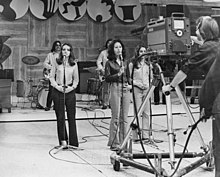| Ki mit tud? | |
|---|---|
 Ki mit tud? recording in 1972 Ki mit tud? recording in 1972 | |
| Hungarian | Ki mit tud? |
| Genre | Talent contest |
| Created by |
|
| Directed by |
|
| Presented by |
|
| Judges |
|
| Country of origin | Hungary |
| Original language | Hungarian |
| No. of seasons | 10 |
| Production | |
| Production company | Magyar Televízió |
| Original release | |
| Network | Magyar Televízió |
| Release | February 13, 1962 (1962-02-13) – November 16, 1996 (1996-11-16) |
Ki mit tud? (Hungarian pronunciation: [ˈki ˈmit ˈtud], literally "Who knows what?") was a multi-genre talent show on the Hungarian National Television spanning 10 seasons between 1962–1996. Achieving great popularity in the 1960s, Ki mit tud? helped to launch the career of many artists who later became household names in the country, including actors like János Gálvölgyi or András Kern, singers like Kati Kovács, Zsuzsa Koncz, Judith Szűcs or Zorán Sztevanovity, and bands like Hungária, Metro or Pokolgép.
Concept
Ki mit tud? was originally conceived as a country-wide talent search, with contestants coming from city-, county-, and finally - the televised, live - country-wide finals. A wide array of genres were judged separately, covering nearly all fields of performing arts: vocal music (including pop, rock, opera, folk), instrumental music (including classical, jazz, dance, pop and rock), verse reading, folk and contemporary dance, and "other" genres (including circus productions, magic shows, stand-up comedy, pantomime or puppetry). The 1988 contest also welcomed amateur film submissions. The jury usually included a number of well-known faces from the country's theatric and music and art scene. Prizes ranged from common household wares to a trip to the next World Festival of Youth, or after the 1980s, luxury trips to exotic countries.
Series overview
| Year | No. of Episodes | Date of premier | Date of the final(s) | Notable performers | Host | President of the Jury | Trip for category winners | |
|---|---|---|---|---|---|---|---|---|
| 1962 | 11 | 13 February 1962 | 24 June 1962 | Béla Bakacsi, Tamás Hacki, Zsuzsa Koncz, Sándor Benkó, András Kern, Metró band | Győző Horváth | Béla Szabó | 8th World Festival of Youth and Students in Helsinki | |
| 1962-63 | 18 | 20 October 1962 | 7 July 1963 | Zorán Sztevanovity, Gyöngyi Keveházi pianist, Géza Molnár Szegedi parodist, Kék Csillag band, Expressz band | Károly Megyeri | Circular tour in the Soviet Union | ||
| 1965 | 13 | 4 April 1965 | 10 June 1965 | 12 June 1965 | Kati Kovács, Anikó Ungár, Mária Zádori singer, Bóbita puppeteers, Teri Harangozó, Kolos Kováts opera singer | László Orosz | Circular tour (including Moscow, Leningrad, Helsinki, Stockholm and East Berlin) | |
| 1968 | 10 | 25 April 1968 | 23 June 1968 | 29 June 1968 | Tolcsvai-trio pol-beat band, András Schiff, Veronika Kincses opera singer, Hungária band, János Gálvölgyi, Neoton, Rangers band | Tamás Major | 9th World Festival of Youth and Students in Sofia | |
| 1972 | 13 | 4 May 1972 | 29 June 1972 | 8 July 1972 | Generál band, Judith Szűcs singer, Béla Berki lead violinist, Mikrolied vocal-trio and Lajos Boros, Gábor Forgács, Viktória Eszményi (all singers) | Circular tour in Yugoslavia and Northern Italy | ||
| 1977 | 10 | 4 February 1977 | 4 April 1977 | Color band, Frigyes Pleszkán jazzpianist, Gúnya parody duo, Vujicsis folk dance group, Kis Rákfogó band, Csaba Szögi folk dancer, Anna Kubik | János Horvát | Circular tour (Warsaw, Leningrad and Helsinki cities were included) | ||
| 1983 | 9 | 20 May 1983 | 24 July 1983 | Mariann Falusi jazz-singer, Studium Dixieland Band, Tamás Ghyczy magician, Csaba Forrás juggling artist, Szélkiáltó folk band, Kati Farkas jazz ballerina, Andrea Rost soprano, Pokolgép | János Gálvölgyi | Circular tour to Cuba | ||
| 1988 | 9 | 27 July 1988 | 17 September 1988 | Tamás Jónás magician, Los Andinos folk band, Swetter folk-rock band, Ernő Fekete, Artúr Kálid | Imre Antal | Miklós Szinetár | Circular tour to Egypt | |
| 1993 | 12 | 1 July 1993 | 18 September 1993 | Enemy Squad breakdance group, János Varga, Roland Rába | Mihály Czine | Circular tour to Thailand | ||
| 1996 | 12 | 28 August 1996 | 16 November 1996 | Veronika Nádasi, Peta Lukács, Csanád Gergely Kováts dancer, Anna Herczenik opera singer, Ödön Rácz double bass player, Mónika Lakatos gypsy folk singer, Savaria Singers choir | Péter Huszti | Circular tour to Mexico | ||
Importance
Ki mit tud? presented a premier chance for performers of all genres to showcase their talents in front of a wider audience - similar to what Táncdalfesztivál meant for musicians.
During the 1960s–1970s, Ki mit tud? became the most-viewed show on National Television. According to the rudimentary statistics of the time, the finals were viewed by 88% of the population. Utilizing regional quarter- and semi-finals, the contest mobilized a large number of participants. 1965's show had 28,642 registered contestants performing in 7842 shows, watched by a live audience totaling to 180,000.
The contest rounds in cities and counties established a country-wide tradition of institutional (e.g. schoolwide) and regional talent contests, with similar events called Ki mit tud? held frequently even today.
Sources
- István, Kollega Tarsoly. A magyar televíziózás műfajai, Vetélkedők Magyarországon a XX. században III. - Kultúra, művészet, sport és szórakozás. Szekszárd : Babits Kiadó, 1998. ISBN 9789639015708
- Hogy volt?!... - Ki mit tud?-ok (in Hungarian). National Audio-visual Archive. Retrieved 2021-03-12.
References
- ""Chapters from the history of the Hungarian Television - Final report of the Ki mit tud? of 1965" X.1". Archived from the original on 2008-08-02. Retrieved 2013-02-06.